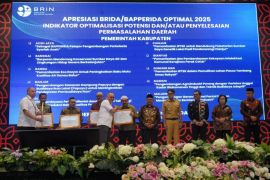Jakarta (ANTARA) - Bioethanol is an energy commodity whose demand has expanded in Indonesia, so product optimization is deemed crucial to reduce the domestic oil and gas import quota, researcher at National Research and Innovation Agency (BRIN) stated.
"Bioethanol is an oxygenate that can be mixed into fuel oil that can increase the octane level and improve combustion in the engine," BRIN's Agroindustry Research Center's researcher, Agus Eko Tjahjono, noted through a statement, Thursday.
Bioethanol is used in several ways in beverages, as a raw material, or a supporter of various industries. It is frequently used as fuel material.
In comparison with the 90 octane equivalent fuel oil, the use of ethanol as fuel oil mix can reduce up to 90 percent of carbon dioxide emissions.
While scientifically, this alternative energy can contribute to emission reduction, the use of bioethanol as a fuel material still encounters several challenges that should be addressed by stakeholders.
Tjahjono outlined that high investment, limited raw materials, and high prices hindered the development of bioethanol in Indonesia. In fact, most of the domestic industries use molasses that is an export commodity.
The efforts to improve the economic value of bioethanol include reducing the factory investment cost, improving process efficiency, and creating by-product and co-product.
"Indonesia has an abundance of raw material sources, and several raw materials, such as starchy or sugary materials, are available without needing land and cultivation. They are numerous, including the sago plant," Tjahjono noted.
Related news: Govt preparing to launch bioethanol filling station in E Java
Moreover, he highlighted that sago is an economically proper material candidate for development of the bioethanol industry in Indonesia.
Sago is known as a plant with high level of sweetness. However, it had yet to be used optimally and has adequate biomass leftover to serve as an energy source for electricity and heat.
Moreover, proper use of sago forests will not destroy the environment.
"It can be integrated with the development of various co-products and the use of by-products to improve its economic value, thereby making it lucrative for the development of sago-based green economy," he remarked.
The bioethanol industry should be developed by applying the integrated bioethanol factory concept. This encompasses combination of the heat and energy system, by-product utilization, and waste management or usage.
Moreover, to improve its economic value, an effort should be made to develop co-products to create a sustainable industry that implements biorefinery principles used to produce energy, food, and other beneficial materials.
"In the end, this industry not only produces bioethanol but also become a sago-based integrated industry," he noted.
Related news: LIPI pushes for development of second generation bio-ethanol
Related news: Indonesia to experiment use of bioethanol fuel










